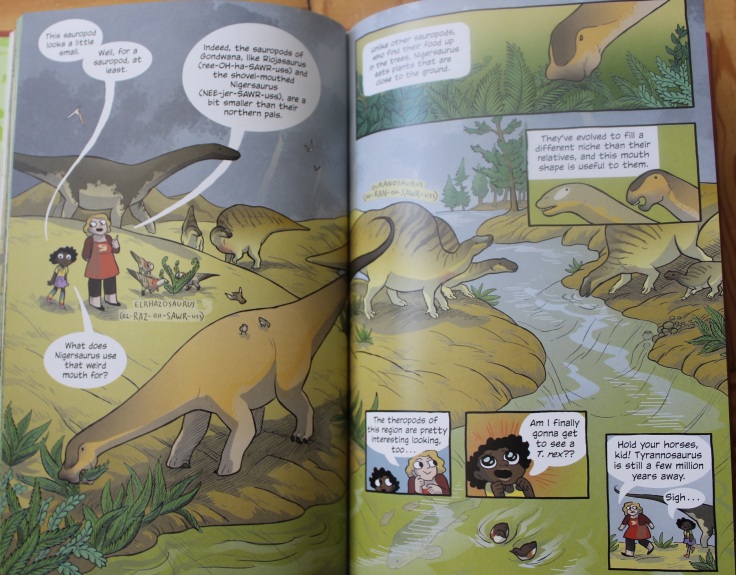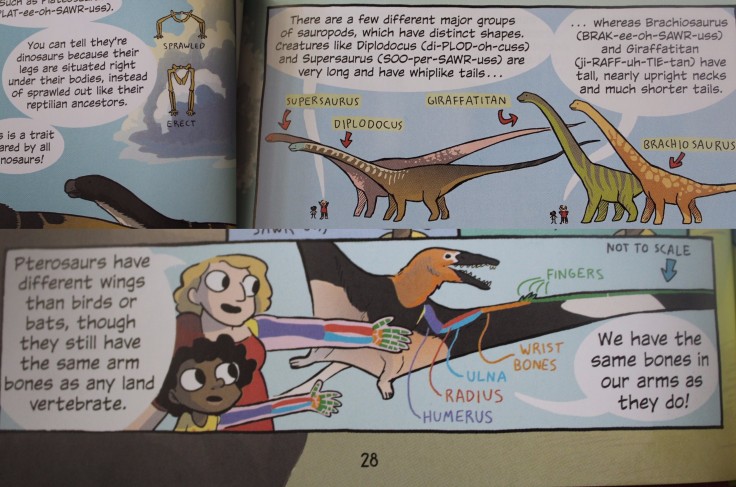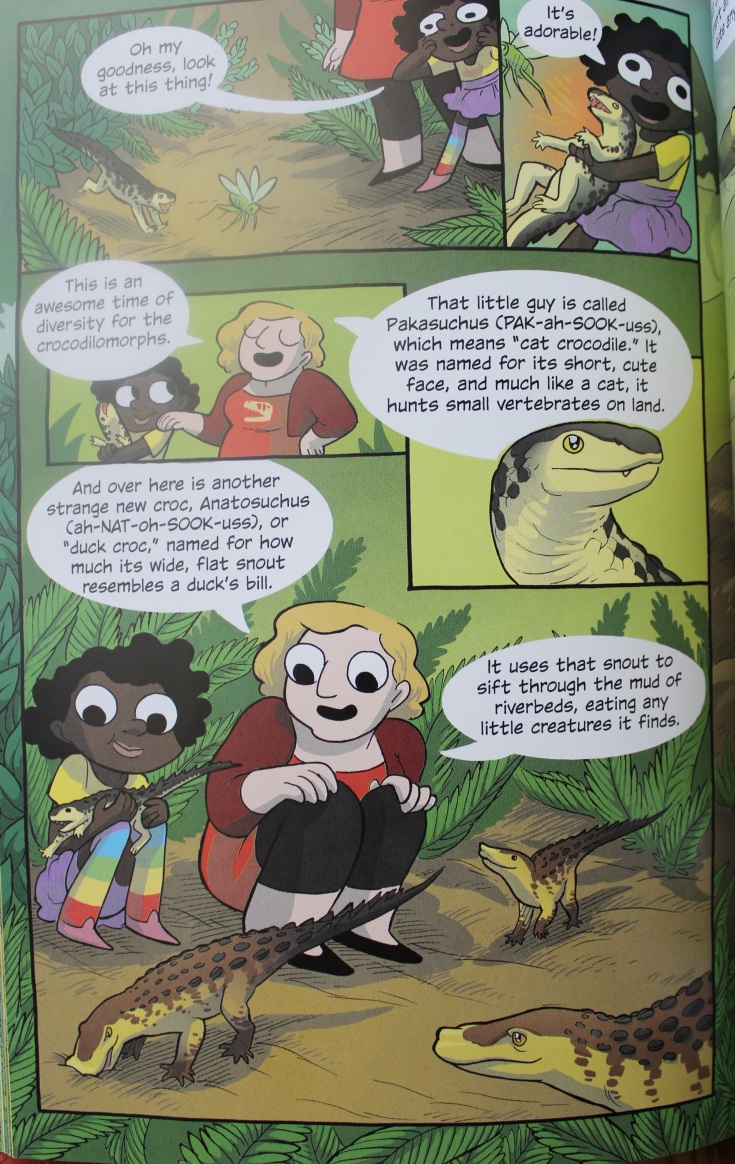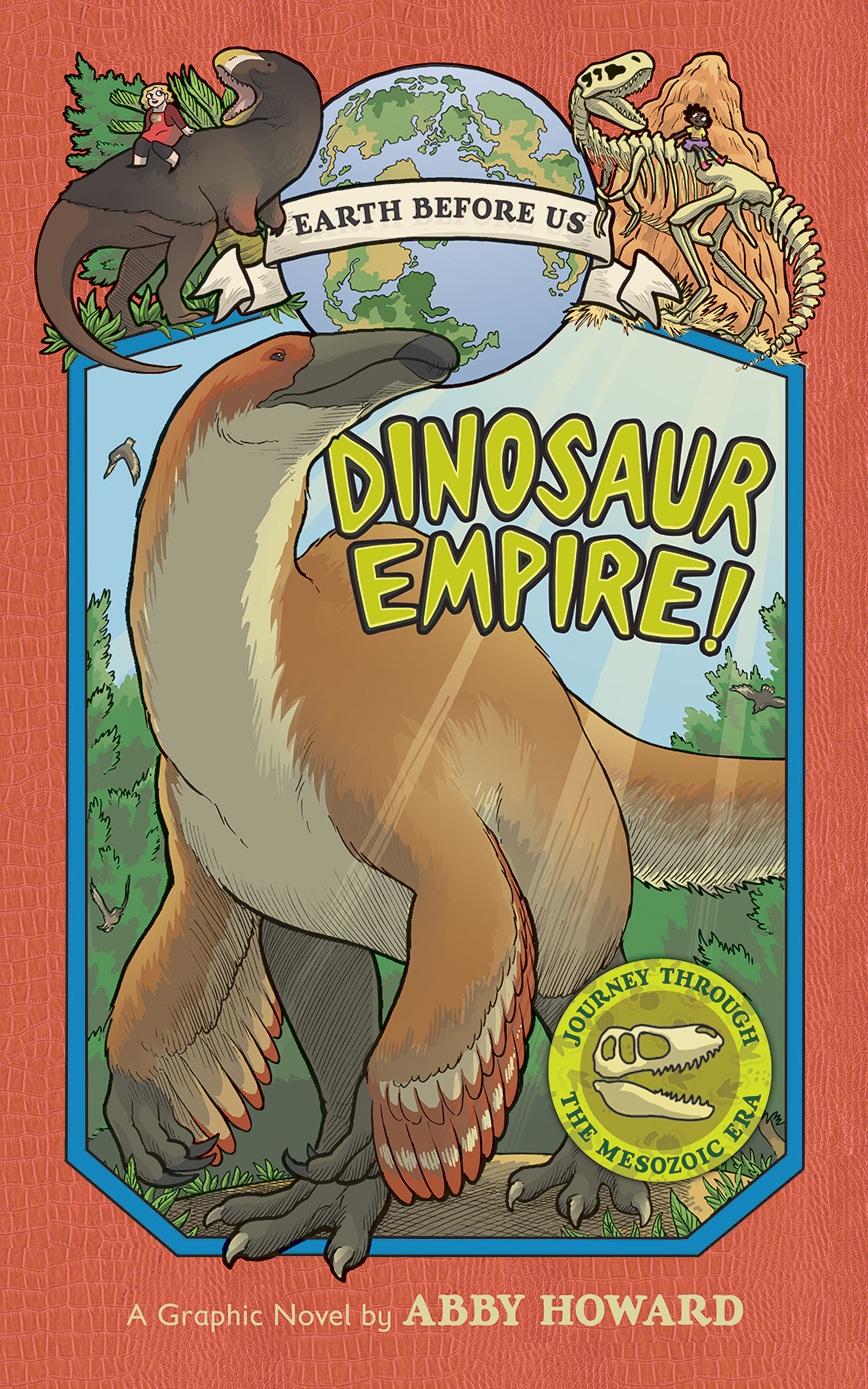The first surprising thing that comes to mind when holding this volume is how it presents itself as a “graphic novel,” which goes a long way to show how the word “comics” has been almost entirely substituted for specific social and educational purposes. After all, not only Dinosaur Empire! is much closer to an encyclopedic discourse (an impulse towards the exhaustive, the sum, the absolute), as its “story structure” is rather flimsy, just enough to make the ball roll in terms of organizing the contents that the author wishes to convey to her young readers.
We start with young Ronnie failing miserably a “dinosaur quiz” in her elementary school. Downcast, her almost unexpected meeting with the eccentric paleontologist Miss Lernin (not only conveniently named as also an available neighbor), and her recycling bin-cum-“time tunnel”, shoot her into an adventure to, as the title of the collection promises, “Earth Before Us.” So, for a hundred pages or so, Miss Lernin introduces and explains to Ronnie and to the eager reader the many creatures we call (sometimes wrongly) “dinosaurs.” Indeed, the main narrative is bookended by more classical takes on character development, but the lion’s share is spent on a more or less linear walk “up” through time and the dozens of different and fascinating mesozoic creatures.

There’s a lot of information packed into this book for younger readers. My guess is that this is a wallop for the kids. It must hit them hard for the sheer number of awesome animals that roam across its pages, and then creates an environment that invites one to go back and peruse each section more calmly. Of course, despite its title and main interest – Ronnie seems obsessed with the classical images of the ravenous, wild T-Rex –, the book explores much more than dinosaurs, presenting ideas in such a manner that it makes clear one how to differenciate actual Ornithischia and Saurischia from pterosaurs or marine reptilians (just like Spider-man taught me that spiders are not insects when I was a kid), or integrate each dinosaur in a more complex and inhabited ecosystem, filled with specific plant life, insects and biological processes. Key concepts such as “phylogenetic trees” or “convergent evolution” are not only introduced, but also become clear visual shortcuts to help in conveying information and even become fodder for the relationship between the young girl and the paleontologist. So while not shying away from such complicated matters, there’s a lot of ways Abby Howard tries to make it palatable for a younger audience (and beyond), as when she provides a simple phonetic guide how to pronounce the several creature’s complicated names (and also etymologies).

If Howard uses mostly a classic comics organization of panels in a page, sometimes she introduces other technical visual strategies, like highlighting details of body parts (say, bones or feathers), very simple diagrams using guidance arrows, trees (of course!), comparisons, and so on. While not always presenting information in a more clear-cut and direct manner, it does keep the interest going. Most of the time however, the two characters are found side by side with the creatures, whether on land, air or underwater, using that which Miss Lernin calls “Science Magic.” And it works!
As of course, not being remotely close to someone who understands what it takes to deal with paleontology and the reconstitution of old forms of life, I cannot even start to imagine the myriad possible discussions about every single detail that is discussed throughout the pages of the book, from color patterns to if Theropoda were feathered or not, to diets and specific filiations. Some of the information is presented in a more or less assured manner, but there are many moments when Miss Lernin explains that some points are actually still open to debate, unexplained or amenable to be revised as soon as new material, theories or methods come up. After all, paleontology is inevitably a revisionist transdisciplinary approach, sometimes dependent on happenstance, perhaps in its infancy still. It is quite probable that within, say, ten years, some of the assumptions in this book may be changed radically, but for the time being this is an updated, great introduction-level book.

As it is expected, the book is organized chronologically, so that the first time-jump puts Ronnie and Miss Lernin in the late Triassic and then they jump forward to the Jurassic, the Cretaceous and the end of the Mesozoic Era. At each epoch, they explore more or less in the same manner the several biota and/or elements and/or phylum, etc. On the one hand, this brings a very neat organization to the contents, which helps for quick comparison between eras, but on the other hand it leads to a somewhat repetitive narrative structure (moe often than not they explore from land to air to seas to mammals to bugs).
But, once again, the main purpose of Dinosaur Empire! is less to tell the specific story of Ronnie (as a character) than to provide a fun, colorful way to present information about these fascinating creatures, the world they lived in and the very methodological processes and rationalization needed to come up with their understanding and explanation. To a certain extent, both Ronnie and Miss Lernin are one-sided characters, one asking questions, the other exposing information, but such is Howard’s choice. One could think of the many strategies that Larry Gonick follows in order to keep his science education and popularization books not only riveting in their conveying knowledge and scientificity but also real fun and entertaining. But Gonick’s readership is somewhat larger, perhaps more adult even. Abby Howard has great skills in composition and in presenting really good, legible and even cute representations of animals and plants (her color work, while straightforward, is really good), but the characters are somewhat diluted into almost-cyphers.

Perhaps, sometimes, Howard’s choice are slightly too cute and simplifying, especially if we think of the standards of scientific illustration. There’s a couple of moments when the creatures are a tad too cute. But then again, one must be reminded that this should be seen as a sort of “first book” on the subject, so the way it makes these animals approachable is not a problem at all. It’s actually both expected and welcomed. It’s a shame that the glossary found at the end of the volume does not pick up again all the specific terms related to the species and other taxonomic ranks, that could act as a quick go-to guide, or that there are no other instruments that could turn this book into a more searchable volume. It’s also curious that for a book that argues that feathered dinosaurs is probably the best look (it turns out it may not be), the cover – outstanding in its 19th century composition pastiche – uses a leathery look for its pattern. But these are minor qualms in a fun, frolicky book about the “big lizzards” (which they’re not, by the by).


Deixe um comentário